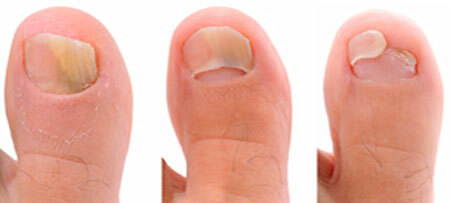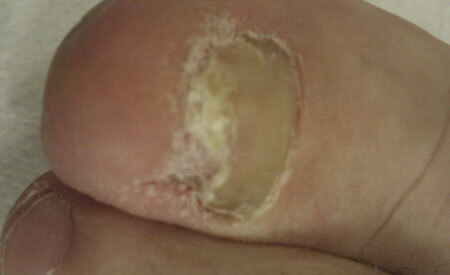Candidiasis is a systemic infectious disease in which not only the skin and mucous membranes, but also the internal organs, can be affected. It is associated with infection with yeast-like fungi from the genus Candide.
The infection is opportunistic, i.e.for its occurrence is not enough only the presence of fungi as a causative factor, it is necessary to weaken the body's immune forces( general or local).
From the disease "candidiasis" should be distinguished by dissemination of yeast fungi. They( in the absence of signs of inflammation) are representatives of normal flora living on skin integuments and mucous membranes.
Contents of
- 1 What is skin candidiasis?
- 2 Causes of skin candidiasis
- 3 Symptoms of skin candidiasis, photo
- 3.1 Diagnosis
- 4 Treatment of candidiasis skin and mucous membranes
- 5 Prevention of candidiasis skin
What is skin candidiasis?

signs of skin candidiasis, photo 1
Candidiasis of smooth skin and mucous membranes is a manifestation of the disturbed existence of fungi and bacteria that normally live on these organs.
Contribute to this:
- skin wounds, abrasions, cracks;
- hormonal changes;
- stress states.
In such conditions the pathogenicity of Candida increases against the background of a decrease in the protective function of the skin and mucous membranes. Endogenous infection( self-infection) of fungi occurs.
As a result, they begin to produce toxic substances, damaging organs and tissues. This further reduces the resistance of tissues - there are secondary dysbacteriosis and bacterial infections.
Therefore, the appearance of a purulent deposit on candidiasis rashes should be regarded as a neglected process. It is an indication for the appointment of antibiotics, and they, in turn, exacerbate the fungal infection.
To warn this vicious circle it is possible, if immediately to begin the purposeful antifungal treatment .
Causes of candidiasis skin
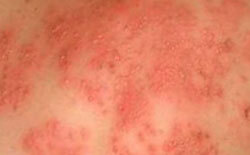 The causes of skin candidiasis are associated with two main factors - the presence of fungi colonizing the epithelium, and a reduced resistance of the body.
The causes of skin candidiasis are associated with two main factors - the presence of fungi colonizing the epithelium, and a reduced resistance of the body.
Today, physicians are particularly concerned about the role of the second factor, because because of him, candidiasis of the skin acquires the features of an epidemic. This was preceded by the following circumstances:
- Unreasonable widespread fascination with antibiotic drugs( they are prescribed even when there is no evidence, often the patients themselves are guilty of this).
- Taking medications that depress the immune system - cytostatics, corticosteroids( they are used in the treatment of asthma, rheumatoid arthritis, lupus erythematosus, etc.), hormonal prevention of pregnancy.
- The spread of radiation treatment in modern medicine.
- Increased incidence of HIV infection and tuberculosis.
- Increased number of transplanted organs, which presupposes lifelong reception of immunosuppressants.
- Diabetes mellitus.
- Surgical interventions on the abdominal cavity.
- Application of endovascular( intravascular) catheters, probes, intubation of the trachea.
- Use of hemodialysis for the treatment of renal failure.
- Dysbacteriosis.
Increased likelihood of a massive injury.
Recently, skin and mucosal candidiasis has been treated as a dangerous nosocomial infection.
According to studies conducted by the Center for Disease Control in Atlanta, up to 12% of weakened patients in clinics get Candidiasis, incl.and visceral forms( with involvement of internal organs).
In 40% of cases this causes death. However, there are undiagnosed cases of candidiasis, which significantly increase the reported indices.
They can be reduced if the necessary preventive measures are taken in time:
- Hand washing by medical personnel.
- Timely treatment of skin diseases of doctors.
- Use of personal accessories for patient care.
- Detection of the initial signs of the disease, etc.
Symptoms of candidiasis of the skin, photo

Development of the disease, photo 2
Given the clinical manifestations, candidiasis is classified into superficial and deep.
The first is divided into three types:
- Cutaneous is a candidiasis of skin and nails.
- Oropharyngeal( candidiasis of facial skin and oral mucosa).
- Urogenital( candidiasis of genital and mucosal skin).
With , deep candidiasis of affects the internal organs, the fungi are sown in the blood. This condition is very serious and in half the cases it ends in a fatal outcome. The source of generalization are skin lesions.
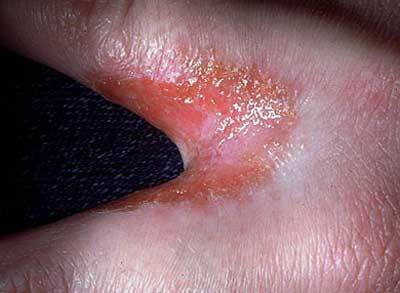
Manifestation of candidiasis between the fingers, photo 3
symptoms of skin candidiasis appear on the interdigital folds( usually 3-4 folds), in the groin and underarms, in the anal area and on the roller surrounding the nail.
They are characterized by the following manifestations:
- Bubbles of small diameter.
- Eroded wet surfaces are dark red. Their boundaries are clear, and the contours are uneven, the epidermis flakes off at the edges.
- On healthy skin, foci of "screening" appear - very small erosions with detachment at the edges in the form of fimbria.
- Scaly patches of red.
Cutaneous candidiasis can be combined with a lesion of the oral mucosa that has specific signs:
- Appearance of white raids( most often on the cheeks, tongue and posterior pharyngeal wall).
- The pain appears when the plaque thickens( in the initial stages it is absent).
- Swallowing is disturbed.
- Spreading the process to the esophagus causes chest pain, reminiscent of that in cardiac problems.
Urogenital candidiasis of skin in women can proceed as candidosis( there is no symptomatology, and a small number of fungi is detected microbiologically) or as an acute and chronic infection. In acute form, clinical signs persist for 2 months.
- redness of the skin of the genitals;
- its puffiness;
- characteristic rashes.
The chronic form of of urogenital candidiasis exists for more than 2 months.
Symptoms are less pronounced, but more diverse:
- Curdle discharge.
- Burning, painless pain.
- Itching. Unpleasant odor.
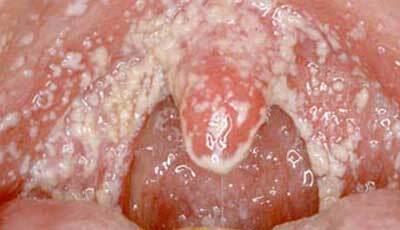
White coating, a sign of candidiasis of the oral cavity, photo 4
Symptoms manifest themselves after sexual intercourse, urination and showering. Chronic form is often accompanied by the development of complications - cystitis and urethritis, while in men it is still epididymitis( inflammation of the epididymis) and prostatitis.
Read more : Features of candidiasis in women
Diagnosis
Diagnosis of superficial forms of candidiasis infection is not difficult. Initially, it is based on clinical data.
In the second stage, laboratory tests are performed to confirm the diagnosis:
- Microscopic examination of scrapings.
- Polymerase chain reaction.
- Sowing on mediums enriched with agar.
Treatment of candidiasis of skin and mucous membranes
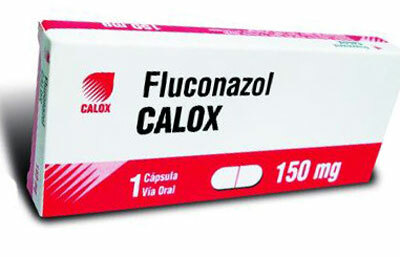
Treatment of candidiasis of skin with fliconazole
Recent epidemiological data suggest that adequate antifungal therapy is prescribed only 15-40% of patients. This is explained by late appeals for help and self-medication.
The only correct solution is an urgent consultation with a doctor for any clinical signs and symptoms, with suspicion of candidiasis of the skin.
The correct treatment is based on a number of principles:
- Limited intake of carbohydrates with food( carbohydrates are "food" for fungi).
- Refusal to smoke and abuse alcohol-containing beverages.
- Purpose of antifungal drugs taken internally.
- In severe clinical cases, vaccination, prescription of antihistamines and immunostimulants are required.
Currently, there are 4 groups of antifungal drugs used to treat skin candidiasis:
- Thiazoles - Fluconazole and Intraconazole.
- Polyenes - Levorin and Nystatin.
- Imidazoles - miconazole, ketoconazole, clotrimazole.
- Other - Iodine, Griseofulvin and others.
This classification helps to correctly orient in the choice of medicines. If the prescribed medicine was ineffective, then it is replaced by a drug from another pharmacological group.
Fluconazole is a modern, inexpensive and effective No. 1 remedy for the treatment of candidiasis.
It has several advantages:
- High bioavailability, so it is effective in any form of the disease.
- The ability to accumulate in keratinizing skin cells, which prevents the recurrence of candidiasis.
- Good effect of tablet form.
- The existence of a solution for intravenous injections, which are prescribed in severe human conditions.
- The possibility of applying a shock dose on the first day of treatment( no toxic effects on the liver).
- Minimal frequency of side effects and absence of toxicity on the body.
- Sufficiently single application throughout the day.
- Fluconazole is approved for use in preterm infants.
 Despite all the advantages, there are cases of therapeutic failure of Fluconazole. They are caused by resistant species of fungi, which are causative agents of candidiasis in 20% of cases.
Despite all the advantages, there are cases of therapeutic failure of Fluconazole. They are caused by resistant species of fungi, which are causative agents of candidiasis in 20% of cases.
In this situation, treatment is carried out with Amphotericin B. B.
The drug is quite toxic, therefore for the period of its use, a person must be in a hospital under the supervision of a doctor and with dynamic laboratory monitoring.
Amphotericin B is especially dangerous for kidneys - the drug is contraindicated in renal pathology.
Prevention of candidiasis skin
The main direction in the prevention of candidiasis is to create conditions for the normal growth of the microflora of the skin and mucous membranes and prevent dysbacteriosis.
Therefore, the important preventive measures are:
- Regular use of lactic-acid foods( yogurt, kefir), preventing dysbacteriosis.
- Restriction of sweetness in nutrition.
- Compliance with hygiene measures.
- Refusal to use antibacterial soap and gel( they disrupt the normal microbial skin landscape, leading to superinfections).
- Use of antibiotics only as directed by the doctor and during the time recommended( you can not cancel them on your own).


